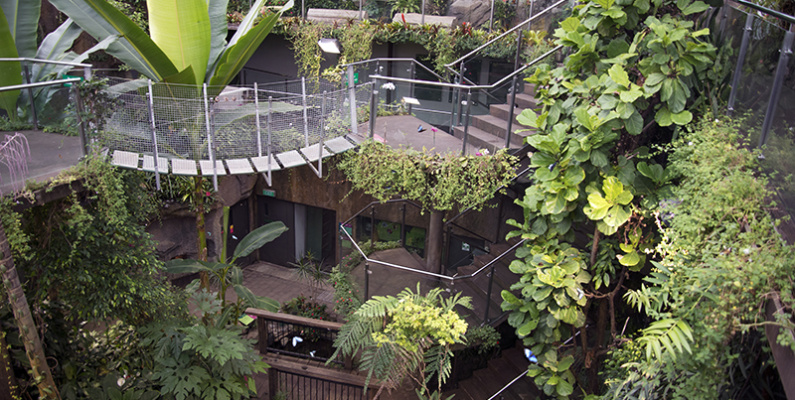
Here at Otago Museum’s Tropical Forest we don’t breed our own butterflies. If we did, the caterpillars would eat all of the foliage and the forest would be unsustainable. Instead, we bring our butterflies in from Costa Rica and the Philippines. They arrive as pupae and hatch on-site, then live out the adult (or butterfly) stage of their lives in the forest. Our butterflies do not lay eggs here because we do not grow the appropriate plants for their caterpillars to eat – it is a natural form of contraception!
This means we need to bring in lots of shipments of butterflies to keep the forest fully stocked. Every Friday we receive a shipment from the Philippines. Let’s take a closer look at the stages of preparation to get our pupae ready for the public.
Our butterflies arrive early in the morning and we pick them up from the front desk (thanks Steve!). We have to be very careful with the box, because it is full of live butterflies.


Once we get the box down into our quarantine room, it is time to open it. The box is mainly full of material to keep the butterflies insulated. This can be either polystyrene or cotton wool.

We peel back the insulation to reveal the pupae beneath. In this shipment are just over one thousand butterflies.

Here is that same layer of pupae without their top insulation. These are two different species. The golden ones at the top are Idea leuconoe, commonly known as paper kites and the green or brown ones are Papilio rumanzovia or scarlet swallowtails. The swallowtails can be green or brown depending on whether they made their chrysalis on a leaf or a branch!


I love the paper kites – I think their pupae are one of the loveliest we get. The pupae come in all shapes and sizes. These little brown ones (on the right) are called Pachliopta kotzebuea or pink rose swallowtails. They are of the same family as the scarlet swallowtails above.


We count and check all our pupae to make sure we have the right numbers. We also check each pupa by hand to make sure it has survived the trip.


Slowly we remove all the pupae from the box and separate them out, ready for the “pinning” process. We have to be very gentle with the pupae and make sure we remove any cotton wool that might get stuck on them.

Here is the shipment all ready to be pinned! This time we received nine different species.
We call the process of hanging the pupae up “pinning” because the process involves pinning strips of pupae onto cork board trays. These are then hung upside down so the butterflies can hatch correctly.
It is very important that we pin the species in the right sequence. When we order the butterflies we choose species that hatch at different rates. For example, the Hypolimnas bolina (great eggfly) pupae need to be pinned as soon as possible, because they will hatch in the next 48 hours.


These are the great eggfly pupae getting pinned.
We pin strips of paper towel onto the cork board and then use a hot glue gun to stick the pupae to the strips. Don’t worry, we are very careful so it doesn’t hurt the pupae. This system means that when we flip the board over, the pupae will hang the right way up, as they would have in the wild.

The whole board is finished! These are the great eggflies and another species called Parthenos sylvia (clipper). The strips are given enough space so that when the butterflies hatch they won’t bump into each other. Very small pupae like these can be much closer together than the larger pupae.

Sweet dreams! See you in a few days!


Here is that first box we saw, with the paper kites and scarlet swallowtails now all ready to be hung up. We have to flip the boards over very carefully in case any of the pupae did not attach to the glue. If everything has gone according to plan they should all sway gently, but be firmly fastened.

These are paper kites from an earlier shipment, hatching at the same time I am preparing today’s shipment. This is how the rows will look after I flip the board over to hang.



They look very different once they are hatched, but if you look closely you can see similarities between the markings on the pupae and the patterns of the wings. These paper kites will now live between one and three weeks. It seems short, but remember, this is only one quarter of their whole lives. They have already been eggs and caterpillars before they arrive in New Zealand.


Here are the boards all hanging up in the forest. We go back into that room before the Museum opens every day and collect any butterflies that are ready to be released. We let them out once a day on weekdays at 11am and twice on weekends at 11am and 1.30pm. That way visitors can enjoy the first flight of our newly-hatched butterflies. So next time you are in the forest, head downstairs and have a close look at the pupae hanging behind the glass – it’s taken a lot of work to get them there and soon they will hatch.
